

BJS: Suggested CogSci Grad Student Reading. Cognitive psychology. Cognitive neuroscience. Cognitive neuroscience is an academic field concerned with the scientific study of biological substrates underlying cognition,[1] with a specific focus on the neural substrates of mental processes.
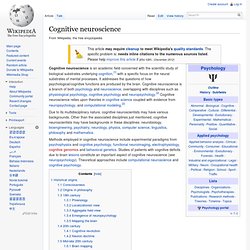
It addresses the questions of how psychological/cognitive functions are produced by the brain. Cognitive neuroscience is a branch of both psychology and neuroscience, overlapping with disciplines such as physiological psychology, cognitive psychology and neuropsychology.[2] Cognitive neuroscience relies upon theories in cognitive science coupled with evidence from neuropsychology, and computational modeling.[2] Due to its multidisciplinary nature, cognitive neuroscientists may have various backgrounds. Other than the associated disciplines just mentioned, cognitive neuroscientists may have backgrounds in these disciplines: neurobiology, bioengineering, psychiatry, neurology, physics, computer science, linguistics, philosophy and mathematics.
Emotional dysregulation. Emotional dysregulation (ED) is a term used in the mental health community to refer to an emotional response that is poorly modulated, and does not fall within the conventionally accepted range of emotive response.
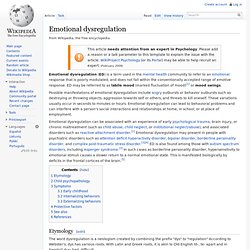
ED may be referred to as labile mood (marked fluctuation of mood)[1] or mood swings. Possible manifestations of emotional dysregulation include angry outbursts or behavior outbursts such as destroying or throwing objects, aggression towards self or others, and threats to kill oneself. These variations usually occur in seconds to minutes or hours. Schema (psychology) In psychology and cognitive science, a schema (plural schemata or schemas) describes an organized pattern of thought or behavior that organizes categories of information and the relationships among them.[1] It can also be described as a mental structure of preconceived ideas, a framework representing some aspect of the world, or a system of organizing and perceiving new information.[2] Schemata influence attention and the absorption of new knowledge: people are more likely to notice things that fit into their schema, while re-interpreting contradictions to the schema as exceptions or distorting them to fit.
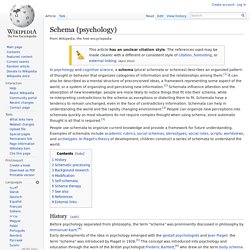
Schemata have a tendency to remain unchanged, even in the face of contradictory information. Schemata can help in understanding the world and the rapidly changing environment.[3] People can organize new perceptions into schemata quickly as most situations do not require complex thought when using schema, since automatic thought is all that is required.[3] Main article: Schema Therapy. Appraisal theory. Appraisal theories of emotion are theories that state that emotions result from people’s interpretations and explanations of their circumstances even in the absence of physiological arousal (Aronson, 2005).[3] There are two basic approaches; the structural approach and process model.
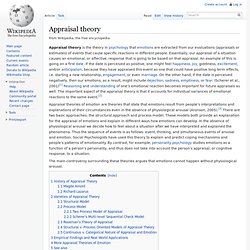
These models both provide an explanation for the appraisal of emotions and explain in different ways how emotions can develop. In the absence of physiological arousal we decide how to feel about a situation after we have interpreted and explained the phenomena. Self-Regulation Theory. Explanations > Theories > Self-Regulation Theory Description | Example | So What?
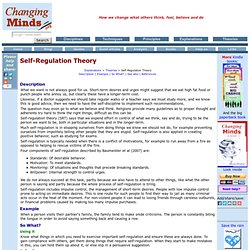
| See also | References Description What we want is not always good for us. Short-term desires and urges might suggest that we eat high fat food or punch people who annoy us, but clearly these have a longer-term cost. Likewise, if a doctor suggests we should take regular walks or a teacher says we must study more, and we know this is good advice, then we need to have the self-discipline to implement such recommendations. The question may even go to what we believe and think. Emotional self-regulation. Emotional self-regulation or regulation of emotion is the ability to respond to the ongoing demands of experience with the range of emotions in a manner that is socially tolerable and sufficiently flexible to permit spontaneous reactions as well as the ability to delay spontaneous reactions as needed.[1] It can also be defined as extrinsic and intrinsic processes responsible for monitoring, evaluating, and modifying emotional reactions.[2] Emotion self-regulation belongs to the broader set of emotion-regulation processes, which includes the regulation of one's own feelings and the regulation of other people's feelings.[3] Theory[edit] Process model[edit] The process model of emotion regulation is based upon the modal model of emotion.
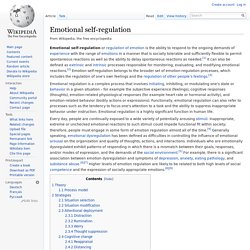
The modal model of emotion suggests that the emotion generation process occurs in a particular sequence over time. This sequence occurs as follows: Situation selectionSituation modificationAttentional deploymentCognitive changeResponse modulation.[11] Cognitive behavioral therapy. CBT has been demonstrated to be effective for the treatment of a variety of conditions, including mood, anxiety, personality, eating, substance abuse, tic, and psychotic disorders.
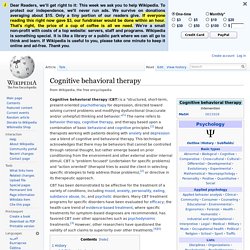
Many CBT treatment programs for specific disorders have been evaluated for efficacy; the health-care trend of evidence-based treatment, where specific treatments for symptom-based diagnoses are recommended, has favored CBT over other approaches such as psychodynamic treatments.[3] However, other researchers have questioned the validity of such claims to superiority over other treatments.[4][5] Coping (psychology) Psychological coping mechanisms are commonly termed coping strategies or coping skills.
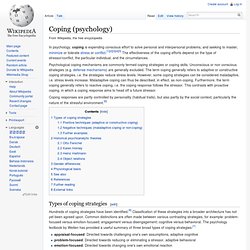
Unconscious or non conscious strategies (e.g. defense mechanisms) are generally excluded. The term coping generally refers to adaptive or constructive coping strategies, i.e. the strategies reduce stress levels. However, some coping strategies can be considered maladaptive, i.e. stress levels increase.
The Extended Mind. The extended mind is an idea in the field of philosophy of mind which holds that the reach of the mind need not end at the boundaries of skin and skull.

Tools, instrument and other environmental props can under certain conditions also count as proper parts of our minds. The EMT[edit] Executive functions. Executive functions (also known as cognitive control and supervisory attentional system) is an umbrella term for the management (regulation, control) of cognitive processes, including working memory, reasoning, flexibility, and problem solving as well as planning and execution.[1][2][3] The prefrontal areas of the frontal lobe are necessary but not solely sufficient for executive functions.

Neuroanatomy[edit] Historically, the executive functions have been seen as regulated by the prefrontal regions of the frontal lobes, but it is still a matter of ongoing debate if that really is the case. Even though articles on prefrontal lobe lesions commonly refer to disturbances of executive functions and vice versa, a review found indications for the sensitivity but not for the specificity of executive function measures to frontal lobe functioning. This means that both frontal and non-frontal brain regions are necessary for intact executive functions.
Phaedo, by Plato.